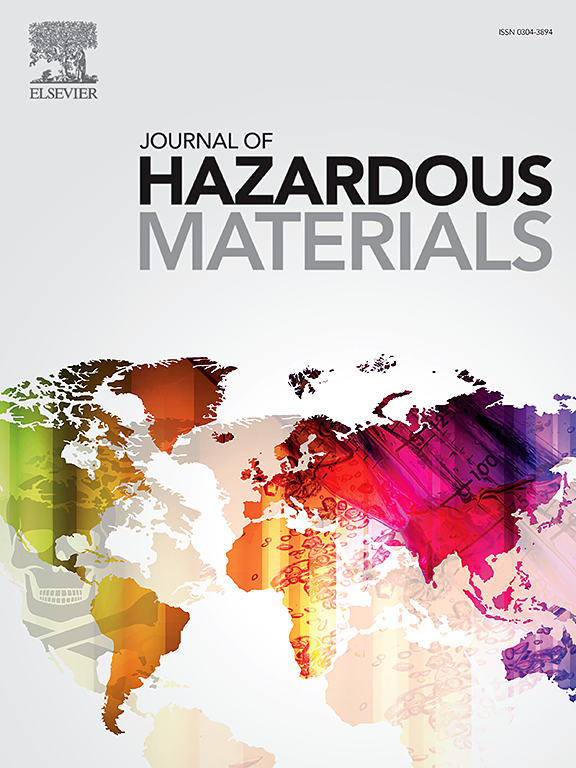Low-Coordinated Cu-Ni Edge Sites in Bimetallic Aerogels for Boosting Electrochemical Nitrate-to-Ammonia Conversion
IF 12.2
1区 环境科学与生态学
Q1 ENGINEERING, ENVIRONMENTAL
引用次数: 0
Abstract
Cu-based electrocatalysts hold significant potential for ammonia (NH3) production through the electrochemical nitrate reduction reaction (NO3−-RR). Optimizing the adsorption of intermediates by tailoring the electronic structure is crucial for enhancing NO3−-RR performance. In this study, we developed small-sized Cu–Ni bimetallic aerogels (Cu–Ni MAs) featuring abundant unsaturated active edge sites to serve as efficient catalysts for NO3−-RR. Compared to Cu-Ni nanoparticles (NPs), these Cu-Ni MAs demonstrated superior intrinsic activity. In a 0.5 M Na2SO4 solution containing 0.01 M NaNO3, the optimized Cu-Ni 3:1 MAs achieved a NH4+ yield of 3.30 mg h−1 mgcat−1 with a Faradaic efficiency (FE) of 80.1% at −0.4 V (vs. RHE), while maintaining a low NO2− byproduct yield of 0.69 mg h−1mgcat−1. Furthermore, the electrochemical active surface area (ECSA)-normalized NH4+ yield of the Cu-Ni MAs was twice that of Cu-Ni NPs. Isotopic labeling experiments with 15N confirmed that the produced ammonia originated from nitrate. DFT calculations revealed that the Cu-Ni edge sites possessed modified electronic properties, characterized by an elevated d-band center and reduced work function. These edge sites exhibited enhanced adsorption of *NO3 and *NO2 intermediates and greater electron availability, contributing to the improved catalytic performance.

双金属气凝胶中Cu-Ni边缘低配位促进电化学硝酸盐转化为氨
铜基电催化剂具有通过电化学硝酸还原反应(NO3−-RR)产生氨(NH3)的巨大潜力。通过调整电子结构来优化中间体的吸附是提高NO3−-RR性能的关键。在本研究中,我们开发了具有丰富不饱和边缘活性位点的小尺寸Cu-Ni双金属气凝胶(Cu-Ni MAs),作为NO3−-RR的高效催化剂。与Cu-Ni纳米粒子(NPs)相比,这些Cu-Ni MAs表现出更好的内在活性。在含有0.01 M NaNO3的0.5 M Na2SO4溶液中,优化后的Cu-Ni 3:1 MAs在−0.4 V(相对于RHE)下的NH4+产率为3.30 mg h−1mgcat−1,法拉第效率(FE)为80.1%,而NO2−副产物产率为0.69 mg h−1mgcat−1。此外,Cu-Ni MAs的电化学活性表面积(ECSA)归一化NH4+产率是Cu-Ni NPs的两倍。15N同位素标记实验证实了氨的生成来源于硝酸盐。DFT计算表明,Cu-Ni边缘位置具有改变的电子性质,其特征是d波段中心升高和功函数减小。这些边缘位点增强了对*NO3和*NO2中间体的吸附,提高了电子可用性,有助于提高催化性能。
本文章由计算机程序翻译,如有差异,请以英文原文为准。
求助全文
约1分钟内获得全文
求助全文
来源期刊

Journal of Hazardous Materials
工程技术-工程:环境
CiteScore
25.40
自引率
5.90%
发文量
3059
审稿时长
58 days
期刊介绍:
The Journal of Hazardous Materials serves as a global platform for promoting cutting-edge research in the field of Environmental Science and Engineering. Our publication features a wide range of articles, including full-length research papers, review articles, and perspectives, with the aim of enhancing our understanding of the dangers and risks associated with various materials concerning public health and the environment. It is important to note that the term "environmental contaminants" refers specifically to substances that pose hazardous effects through contamination, while excluding those that do not have such impacts on the environment or human health. Moreover, we emphasize the distinction between wastes and hazardous materials in order to provide further clarity on the scope of the journal. We have a keen interest in exploring specific compounds and microbial agents that have adverse effects on the environment.
 求助内容:
求助内容: 应助结果提醒方式:
应助结果提醒方式:


